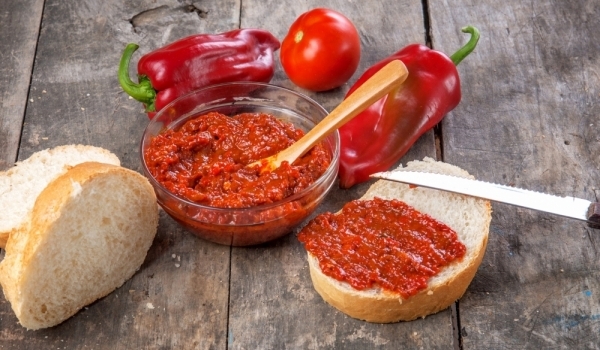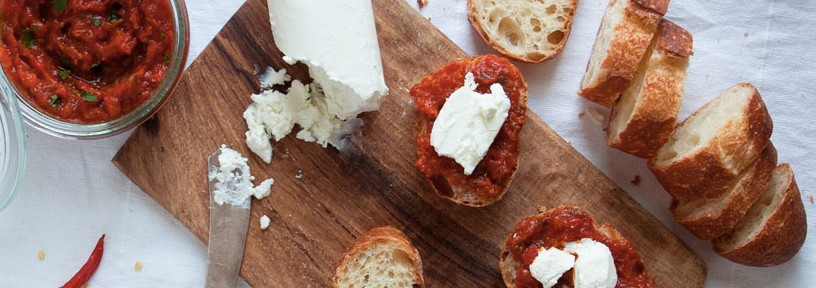Lyutenitsa has always been more than just a condiment in my family—it’s a tradition, a memory, and a symbol of togetherness. If you grew up in Bulgaria, chances are you’ve had it on a thick slice of bread as a child, tasted it straight from the spoon in your grandmother’s kitchen, or helped stir it in a large pot while the smell of roasted peppers filled the air. This is our story with lyutenitsa—and perhaps, yours too.
What Is Lyutenitsa?
Lyutenitsa (лютеница) is a traditional Bulgarian spread made primarily from roasted red peppers, tomatoes, carrots, garlic, and spices. While recipes vary across regions and households, the heart of lyutenitsa remains the same: simple vegetables turned into a rich, sweet, smoky spread through careful cooking and family effort.
Some versions are spicy (as the name “lyuto” suggests), others are sweet and mild. Some are smooth like a purée, others chunky with visible pieces of pepper and eggplant. But the soul of lyutenitsa—its comforting taste and homemade authenticity—is universal.
A Family Tradition
Every autumn, when the harvest season peaks, our family gathers to prepare a large batch of lyutenitsa. It’s a full-day affair and often begins the night before. Peppers are washed, tomatoes are blanched, carrots peeled, and eggplants roasted. It’s a labour-intensive process, but it’s also a celebration.
For us, making lyutenitsa is a multigenerational event. My mother oversees the pot. My father manages the fire and the roasting. The children help peel the roasted peppers—a task that leaves hands stained red but spirits high. We all share stories, laughter, and the occasional argument about how much salt to use. This is the essence of Bulgarian family cooking: practical, emotional, and deeply rooted in community.
The Ingredients Matter
Our family recipe uses:
- Red bell peppers (roasted and peeled)
- Ripe tomatoes (cooked down to a thick sauce)
- Carrots (boiled and mashed)
- A small amount of eggplant (roasted)
- Garlic and sunflower oil
- Salt, sugar, and black pepper to taste
Some families add onions, others don’t. Some include a pinch of cumin or paprika. The roasting and slow cooking give lyutenitsa its unmistakable depth of flavor. We cook ours in a large open pot over a wood fire, stirring constantly until it reaches the right consistency—thick enough to hold its shape on a spoon, but soft enough to spread easily.
From Pantry to Table
Once ready, the hot lyutenitsa is spooned into sterilized jars and sealed. We store these jars for winter, and they never last long. A slice of crusty bread with lyutenitsa is often our breakfast, especially when paired with Bulgarian white brined cheese (sirene). It also goes perfectly with grilled meats, sausages, or as a dip for fries.
My children love it on toast. My parents use it in stews. I sometimes eat it straight from the jar when nobody’s looking. Its versatility makes it a must-have in every Bulgarian home.
Lyutenitsa Around Bulgaria
Although the basic idea of lyutenitsa is shared across the country, every region—and every family—puts its own twist on it. In Plovdiv, you might find a sweeter version. In the north, more eggplant. In the Rhodope Mountains, lyutenitsa is often coarser and spicier.
Store-bought lyutenitsa is available in every supermarket, with brands offering smooth or chunky textures, hot or mild varieties. But ask any Bulgarian, and they’ll likely say homemade is best. Why? Because it carries the flavor of home, of tradition, and of someone’s hard work and love.
A Taste of Home, Abroad
Living abroad, I’ve realized how powerful lyutenitsa is as a connection to Bulgaria. A spoonful can bring back childhood memories in an instant. That’s why I still make it, even in smaller batches, even in a different kitchen. My family now continues the tradition in a new country—but the essence remains.
We import Bulgarian peppers or grow our own. We roast them on a grill. We use Bulgarian sunflower oil, and when we can’t find it, we adapt. But the goal is the same: to preserve a taste that feels like home.
Why It Matters
In a world of fast food and prepackaged sauces, lyutenitsa reminds us of the beauty of slow, seasonal cooking. It teaches patience. It brings people together. It nourishes not just the body, but the soul.
When I make lyutenitsa with my family, I’m not just preparing food—I’m passing on knowledge, habits, and stories. My children will one day remember the smell of roasted peppers, the sound of the spoon scraping the bottom of the pot, the warmth of their grandparents’ laughter.
That’s why lyutenitsa matters to us—and to many Bulgarian families.
Conclusion
Lyutenitsa is not just a condiment. It’s part of who we are. It’s a symbol of heritage, a ritual of love, and a jar full of memories. Whether you’re enjoying it in a mountain village in Bulgaria or in a city apartment abroad, the taste of lyutenitsa brings you home.
If you haven’t tried it yet, make a jar—or ask a Bulgarian friend for one. Just be warned: once you start, one slice of bread is never enough.Lyutenitsa has always been more than just a condiment in my family—it’s a tradition, a memory, and a symbol of togetherness. If you grew up in Bulgaria, chances are you’ve had it on a thick slice of bread as a child, tasted it straight from the spoon in your grandmother’s kitchen, or helped stir it in a large pot while the smell of roasted peppers filled the air. This is our story with lyutenitsa—and perhaps, yours too.
What Is Lyutenitsa?

Lyutenitsa (лютеница) is a traditional Bulgarian spread made primarily from roasted red peppers, tomatoes, carrots, garlic, and spices. While recipes vary across regions and households, the heart of lyutenitsa remains the same: simple vegetables turned into a rich, sweet, smoky spread through careful cooking and family effort.
Some versions are spicy (as the name “lyuto” suggests), others are sweet and mild. Some are smooth like a purée, others chunky with visible pieces of pepper and eggplant. But the soul of lyutenitsa—its comforting taste and homemade authenticity—is universal.
A Family Tradition
Every autumn, when the harvest season peaks, our family gathers to prepare a large batch of lyutenitsa. It’s a full-day affair and often begins the night before. Peppers are washed, tomatoes are blanched, carrots peeled, and eggplants roasted. It’s a labour-intensive process, but it’s also a celebration.
For us, making lyutenitsa is a multigenerational event. My mother oversees the pot. My father manages the fire and the roasting. The children help peel the roasted peppers—a task that leaves hands stained red but spirits high. We all share stories, laughter, and the occasional argument about how much salt to use. This is the essence of Bulgarian family cooking: practical, emotional, and deeply rooted in community.
The Ingredients Matter
Our family recipe uses:
- Red bell peppers (roasted and peeled)
- Ripe tomatoes (cooked down to a thick sauce)
- Carrots (boiled and mashed)
- A small amount of eggplant (roasted)
- Garlic and sunflower oil
- Salt, sugar, and black pepper to taste
Some families add onions, others don’t. Some include a pinch of cumin or paprika. The roasting and slow cooking give lyutenitsa its unmistakable depth of flavor. We cook ours in a large open pot over a wood fire, stirring constantly until it reaches the right consistency—thick enough to hold its shape on a spoon, but soft enough to spread easily.
From Pantry to Table
Once ready, the hot lyutenitsa is spooned into sterilized jars and sealed. We store these jars for winter, and they never last long. A slice of crusty bread with lyutenitsa is often our breakfast, especially when paired with Bulgarian white brined cheese (sirene). It also goes perfectly with grilled meats, sausages, or as a dip for fries.
My children love it on toast. My parents use it in stews. I sometimes eat it straight from the jar when nobody’s looking. Its versatility makes it a must-have in every Bulgarian home.
Lyutenitsa Around Bulgaria
Although the basic idea of lyutenitsa is shared across the country, every region—and every family—puts its own twist on it. In Plovdiv, you might find a sweeter version. In the north, more eggplant. In the Rhodope Mountains, lyutenitsa is often coarser and spicier.
Store-bought lyutenitsa is available in every supermarket, with brands offering smooth or chunky textures, hot or mild varieties. But ask any Bulgarian, and they’ll likely say homemade is best. Why? Because it carries the flavor of home, of tradition, and of someone’s hard work and love.
A Taste of Home, Abroad
Living abroad, I’ve realized how powerful lyutenitsa is as a connection to Bulgaria. A spoonful can bring back childhood memories in an instant. That’s why I still make it, even in smaller batches, even in a different kitchen. My family now continues the tradition in a new country—but the essence remains.
We import Bulgarian peppers or grow our own. We roast them on a grill. We use Bulgarian sunflower oil, and when we can’t find it, we adapt. But the goal is the same: to preserve a taste that feels like home.
Why It Matters
In a world of fast food and prepackaged sauces, lyutenitsa reminds us of the beauty of slow, seasonal cooking. It teaches patience. It brings people together. It nourishes not just the body, but the soul.
When I make lyutenitsa with my family, I’m not just preparing food—I’m passing on knowledge, habits, and stories. My children will one day remember the smell of roasted peppers, the sound of the spoon scraping the bottom of the pot, the warmth of their grandparents’ laughter.
That’s why lyutenitsa matters to us—and to many Bulgarian families.
Stay Tuned!
Soon Lutenitsa will be available in the UAE on Amazon
Conclusion
Lyutenitsa is not just a condiment. It’s part of who we are. It’s a symbol of heritage, a ritual of love, and a jar full of memories. Whether you’re enjoying it in a mountain village in Bulgaria or in a city apartment abroad, the taste of lyutenitsa brings you home.
If you haven’t tried it yet, make a jar—or ask a Bulgarian friend for one. Just be warned: once you start, one slice of bread is never enough.





